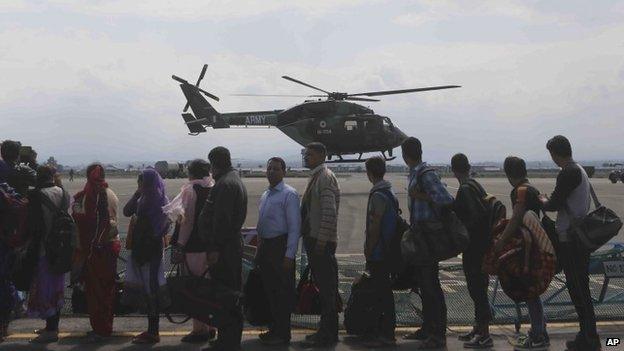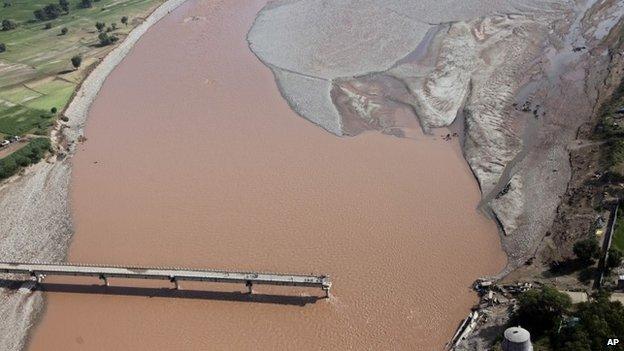Kashmir flood relief operation a major challenge
- Published

The air force is using helicopters to drop relief supplies and evacuate people
Tens of thousands of people are still stranded in Indian-administered Kashmir after the worst floods in half a century. With road and communication links cut off, the Indian military is using helicopters and boats to reach those in distress. The BBC's Sanjoy Majumder was on board a relief flight to witness the impact of the floods.
At the Jammu air base, there is a flurry of activity in the early hours of the morning.
A fleet of Russian-built Mi-17 helicopters are being loaded up with supplies.
Our aircraft is bound for Kishtwar, deep in the Kashmir Valley, which remains cut off because of the floods.
It's carrying sacks and crates of rations - vegetables such as onions, potatoes, tomatoes and eggplant among others.
"The main rescue phase is now over for the most part and our priority now is to provide relief to those in need," says Air Commodore PE Patange, who is in charge.
Receding water
"We have shipped medicines and taken doctors to some of the most remote areas.
"We have also taken rations as well as tents and other material to Srinagar," he adds.
From the air, as we head towards the Kashmir Valley, we get a sense of the impact of the floods.
The water has receded in most places and the rivers are no longer overflowing.
But there are plenty of signs of destruction - eroded riverbanks, bridges destroyed, a pile of debris where a road once stood, a communication tower on its side.
"Just a few days ago, all of this was covered in water," one of the crewmen tells me, pointing down to the lush green landscape with the Chenab river snaking through it.

The rain has eased off but many parts of Kashmir are still inaccessible
Forty-five minutes later, we arrive at Kishtwar, a small town up in the mountains surrounded by alpine forest.
As soon as we land, soldiers begin unloading the precious cargo and transfer it to military trucks waiting nearby.
Apart from the supplies on our aircraft, the tarmac is laden with other essentials. Cartons of milk, live chickens and medicine are all loaded on to the trucks.
These will now be taken further up the mountains and then soldiers will trek up with the supplies to areas which are cut off.
Normally these supplies would have been transported by road, from the main highway connecting the Kashmir Valley with the plains in the south and beyond.
Major problem
But a part of the road's been damaged and no supplies have been reaching the markets and the communities up in the mountains.
And even in Kishtwar, there is a major problem.
With phone lines down, communicating with teams on the ground is becoming difficult except through high frequency wireless sets.
Getting through to the state capital, Srinagar, is particularly difficult.
"The last few days were very challenging," says Air Commodore Patange.
"Entire areas were submerged and there was no place to land our helicopters. We had to drop supplies from the air and evacuate people using winches and ropes."
It's not raining any more and with the water receding, the relief operation has picked up.
After this will begin the reconstruction and rehabilitation process which will be infinitely more challenging.
Communication links have to be restored after which the authorities will have to start rebuilding the villages and communities which have been destroyed.
It will be a long process which could take months - maybe even years.
- Published9 September 2014
- Published6 September 2014

- Published7 September 2014
